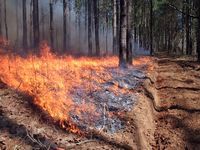Biggest Issues Facing Sierra Forests and Forest Communities
Someone asked me today what the biggest issues are facing Sierra forests and the surrounding communities. I think this is a good place to start the Saving the Sierra “Forests Blog”, and I hope that my thoughts will elicit other thoughts and comments and kick off a discussion around these important issues. Not necessarily ranked in order of importance, I will add issues over the course of the week:
Catastrophic Wildfire

(wildfire)

(controlled burn)
As a result of past timber harvesting and fire suppression much of our region's forestland is overgrown-- dense with small trees and shrubs that act as kindling, ready to ignite. Historically, Sierra forests burned with some regularity, the fires spread slowly and covered fewer acres, and many of the larger trees were resistant to the flames which stayed relatively low to the ground. Regular fire in a forest helps protect the trees from insects and disease, improve habitat for wildlife, and release seeds from serotinous cones (which need heat to become "unglued").
Catastrophic wildfire today burns hotter, spreads faster and further, and can kill even the oldest, most resilient trees. Furthermore, these fires will scorch all of the nutrients and life out of the soil so that even hardy pioneer species cannot grow, and the land is effectively sterilized.
Restoring Sierra forests so that they are not so susceptible to catastrophic wildfire is a huge, expensive, and daunting task. It often requires manual thinning followed by reintegrating fire into the ecosystem. Cutting the small trees and shrubs is time consuming and expensive. There are few viable markets for small diameter trees, so often to help pay the costs of thinning, some larger trees, up to 30 inches in diameter, are harvested and sold. Developing new markets and new value-added products for small diameter timber could potentially reduce the quantity of larger trees harvested while providing enough value to pay for the forest restoration.














Wildfire Top of the List
It is great to hear and learn more about forests in the Sierra--one of our key resources and the source of so much discussion at many of the meetings I have been to lately. At the last two Sierra Nevada Conservancy meetings, for example, catastrophic wildfire came up as a top issue facing local communities. There seems to be a lot of focus on the possibility of catostrophic fire, but I haven't heard too much in the way of proposed solutions, or steps to take to address the issue. And I'd like to know more. What steps or solutions have you been coming across? One you mention is developing new markets and new value added products for small diameter timber. Where is this happening (the "Doing Good With Wood" project in Calaveras County?)
Looking forward to continuing the conversation
jesikah maria ross, Co-Project Director Saving The Sierra: Voices of Conservtion In Action
Call for Solutions to the Wildfire Challenge...
Betony Jones
Forestry Program Director
Sierra Business Council
530/582-4800 x.309
Solution: thinning
Quincy Library Group
At the same time, QLG is not without its critics. The size and quantity of trees removed from National Forest Land are absolutely no different than if any other timber company was doing this work. They take as many big trees as any other operation. This is because the Forest Service marks the trees for removal, and the only way to pay for thinning is to sell some of the bigger (up to 30 inches dbh, I believe) trees. In effect, I have seen QLG projects (not the ones easily accessible or close to the road) that do not leave beautiful, mixed age, multi-story stands.
This is not because QLG has a bad model; rather it is because thinning for fire management is really expensive, and to get the work done in the current market, the Forest Service's solution to sell some of the bigger "medium" trees that have commercial value.
I might suggest a few conversations for the group to pursue from the posted comment.
1) Is the above "trade off" (i.e. selling bigger trees to pay for thinning) worth it? What other options exist to make thinning/restoration work financially viable?
2) Is the goal to create "fire resistant" forests? In pre-settlement conditions, fire was a very natural process that maintained Sierra forests in that state. Based on all the environmental, social, and economic factors, should we aim to re-integrate fire into these ecosystems? Or practice other management techniques in order to keep fire at bay?
Thoughts?
Betony Jones
Forestry Program Director
Sierra Business Council
530/582-4800 x.309
Post new comment